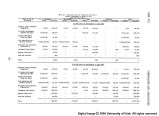| OCR Text |
Show PART VII COMPARISONS AND CONCLUSIONS resource base. However, synthetic fuel potential from oil shale, rock asphalt, and coal offers alternatives that can relieve demand pressure on conventional fuels. The on-coming development of the uranium breeder reactor, which would produce the fuel plutonium, would, also replace con- ventional fuels. Watershed management If no additional watershed land treatment or flood protection pro- grams are initiated, average annual damages will increase from the pres- ent $8.7 million to $25.6 million by 2020, assuming the framework plan level of development. Management and protection programs include land treatment on 2k million acres and installation of 78*000 water control structures. These will correct most of the existing problems that can be treated. Increased protection is an integral part of the future produc- tion activity. Cost of the erosion, flood, and sediment prevention and the water yield improvement programs in terms of average per-year expendi- tures for installation and operation, maintenance, and replacement for 1966 to 2020 is fek.k million. Erosion, the most significant problem affecting 30.5 million acres, requires an immediate action program to treat 3*9 million acres in criti- cal erosion condition. Watershed treatment programs needed to correct the treatable exist- ing problems will be the same for all alternatives, and will be accom- plished if funding is available. The "going program" based on 1964-69 level of development would accomplish about 78 percent of the proposed program. The additional protection needed for states' alternatives will be an integral part of the increased development cost. Flood control Without additional flood damage reduction measures, annual flood damage is estimated to increase from $2.8 million (196^) to approximately $4.2 million by 1980, $6.8 million by 2000, and $10.6 million by 2020. To reduce the hazards to health and human life and excessive economic losses from floods, an appropriate degree of protection should be pro- vided through structural and nonstructural measures, consistent with other uses of water and land resources. The future flood damage reduc- tion program consists of 0.2 million acre-feet of single-purpose flood control storage and 2.1 million acre-feet of multipurpose storage capac- ity; construction of 9 miles of levees and 11 miles of channel improve- ment; nonstructural measures including improved flood forecasting, dis- semination of flood hazard information, flood plain zoning, and other measures by local authorities; and land treatment on 7 million acres under watershed, management programs. The program would reduce potential annual flood damages by $6.7 million in the year 2020. 104 |













































































































































